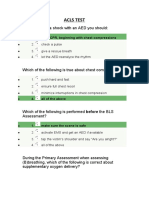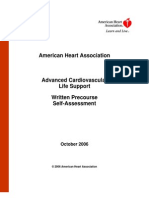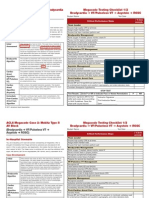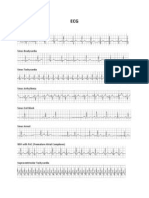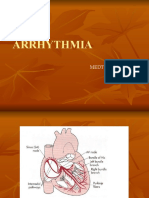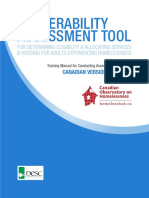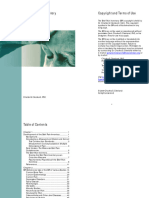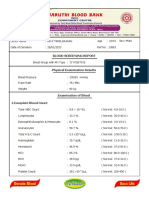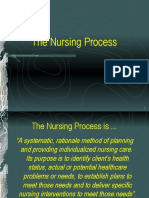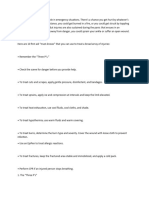Register Now Login
ACLS Algorithms 2020 (Advanced
Cardiac Life Support)
Introduction: What is Advanced Cardiac Life
Support (ACLS)?
ACLS is an acronym that stands for Advanced
Cardiac Life support. The ACLS certi9cation course
teaches healthcare professionals advanced
interventional protocols and algorithms for the
treatment of cardiopulmonary emergencies. These
include primary survey, secondary survey, advanced
airways, myocardial infarction, cardiac arrest,
tachycardias, bradycardias, and stroke. The
treatment protocols have been established through
collaborative clinical research and later published by
the International Liaison Committee on
Resuscitation (ILCOR).
CPR for Adults (CABD)
CPR for Children (CABD)
CPR for Infants (CABD)
Choking Intervention for Adults & Children
Choking Intervention for Infants
Secondary ABCD (Adults)
Airway and Breathing
Advanced Airways
Cardiac/Electrical Therapy
Cardiac Rhythms
Acute Myocardial Infarction
Tachycardias
Bradycardias
Asystole
Pulseless Electrical Therapy (PEA)
Acute Stroke
ACLS Case Scenarios
Need ACLS Certification?
Certify Recertify
169 119
Continue Continue
Secondary ABCD (Airway, Breathing,
Circulation, Differential Diagnosis)
Airway (two provider)
Initially provide rescue breaths using an ambu
bag and a mask at full Eow oxygen.
Perform continued assessment of airway
patency while giving breaths.
Have the person doing chest compressions
pause during the 2 rescue breaths.
If the patient is not ventilating well or if there is a
presumed risk of aspiration, insert an advanced
airway device when prudent:
Endotreacheal Intubation is the preferred method.
(View the advanced airway section)
Breathing
Con$rm correct placement of the advanced airway
device:
Look for condensation during exhalation.
Look for equal bilateral chest rise.
Con9rming equal bilateral breath sounds with
auscultation.
Auscultate stomach to assure esophageal
intubation didn’t occur.
End-tidal CO2 should be veri9ed during
exhalation using monitor or ETD
Use portable chest x-ray.
If incorrect placement:
Remove the airway device, ventilate the patient
using the ambu bag for a short period of time,
and then reattempt placement.
If correct placement:
Secure placement of the airway device.
Continue to monitor:
oxygenation saturation with pulse oximeter
end-tidal CO2
Rescue breathing during CPR with an advanced
airway:
8-10 breaths per minute (1 breath every 6-8
seconds)
Chest compressions should be given
continuously at a rate of 100 to 120 per
minute.
Circulation
Obtain IV or IO access.
Monitors (ECG, BP cuff, pulse oximeter, et CO2
monitor)
Identify:
heart rhythm
Obtain a 12 lead ECG if possible.
Initiate therapy of ACLS algorithm
corresponding with the identi9ed heart rhythm.
(Drug therapy, Electrical therapy, Pacing, etc.)
Differential Diagnosis
(needed for successful treatment of some
patients)
Consider reversible causes of rhythm/arrhythmia.
Differential Diagnosis Chart:
Airway & Breathing
There are two important principles when
evaluating the airway and breathing. First, is the
airway patent or obstructed. Second, is there
possible injury or trauma that would change the
providers method of treating an obstructed airway
or ine\cient breathing.
Patent/obstructed
If the airway is patent there should be noticeable
chest rise/expansion with either spontaneous
respirations or with rescue breaths. The provider
may also be able to hear or feel the movement of
air from the patient.
A completely obstructed airway will be silent. An
awake patient will lose their ability to speak, while
both a conscious or unconscious patient will not
have breath sounds on evaluation. If the patient is
attempting spontaneous breaths without success,
there may be noticeable effort of intercostal
muscles, diaphram, or other accessory muscles
without signi9cant chest rise/expansion. The
provider will also not feel or hear the movement
of air. If the airway is partially obstructed snoring
or stridor may be heard.
Cervical Spine Injury?
If the provider evaluates the patient to have an
obstructed airway, intervention should take place.
If the adverse event of the patient was witnessed
and there is no reason to suspect a cercival spine
injury, the provider should use the head tilt-chin lift
maneuver to open the airway.
If there is a reason to suspect a cervical spine
injury, if the patient’s adverse event went
unwitnessed, if trauma occured, or the patient
suffered drowning the jaw-thrust maneuver
should be used to open the airway. If the jaw-
thrust proves unsuccessful in opening the
patient’s airway attempt an oropharangeal or
nasopharangeal airway. If neither technique
works, attempt an advanced airway using inline
stabilization.
Brain Injury?
The breathing center that controls respirations is
found within the pons and medulla of the brain
stem. If trauma, hypoxia, stroke, or any other form
of injury affects this area, changes in respiratory
function may occur. Some possible changes are
apnea (cessation of breathing), irregular breathing
patterns, or poor inspiratory volumes. If the
breathing pattern or inspiratory volumes are
inadequate to sustain life, rescue breathing will be
required, and an advanced airway should be
placed.
Oral Airway:
Assure the arti9cial airway is the appropriate
size for the patient.
The airway should be easily inserted with a
tongue blade.
Avoid use in patients with an active gag reEex.
Nasal Trumpet Airway:
Best practice is to lube before insertion.
Careful not to cause trauma to nasal mucosa
(results in bleeding).
This is reasonably tolerated by patients with
an active gag reEex.
Advanced Airways
Indications:
When you are unable to open airway using
head tilt-chin lift or jaw thrust maneuvers.
If you have di\culty forming a seal with the
face mask.
If the patient requiring continued ventilatory
support.
When the patient has a high risk for aspiration
(provide an ETT or Combitube).
Remember, a patient should be unconscious or
sedated without an active gag reEex before
instrumentation of the airway occurs with an ETT,
Combitube, or LMA.
Endotracheal Tube (ETT)
Requires additional instrument for insertion
(laryngoscope, glidescope, 9beroptic).
Laryngoscope blades (average adult size):
MAC 3 or 4, Miller 2 or 3. ETTs require mastery
of technique for consistent appropriate
placement.
Average size of ETT for orotracheal intubation
for adults is 7.5mm.
The ETT is placed into the trachea, having
direct visualization of the vocal cords.
Average depth of intubation:
adult male is 23cm
adult female is 21cm
Tracheal cuff of the ETT is then inEated.
Allows for positive pressure ventilation.
Reduces risk of aspiration.
Helps maintain placement of ETT.
Con9rm placement of ETT.
Secure in place of ETT.
Esophageal-Tracheal Combitube
Gently advance the combitube into the mouth
midline along the base of the tongue.
Assure tube rotation of the combitube is
following the curvature of the pharynx.
Cease advancement of the tube once the
heavy black rings reach the patient’s teeth.
The Combitube is blindly placed into the
esophagus 80% of the time and into the
trachea 20% of the time.
The combitube provides ventilatory access
irregardless of tracheal or esophageal
intubation.
InEate the pharangeal cuff with 100ml of air.
Prevents leak through the nose and mouth.
Helps secure placement.
InEate the tracheal cuff with 15ml of air.
Prevents ventilation of stomach. Reduces risk
of aspiration of stomach content.
Secure in place of ETT.
First attempt con9rmation of esophageal
intubation by ventilating through the esophageal
tube. (See “Secondary ABCD” section regarding
placement con9rmation)
If placement not con$rmed through esophageal
tube:
Attempt con9rmation of tracheal intubation by
ventilating through the tracheal tube. (See
“Secondary ABCD” section regarding
placement con9rmation)
Once placement has been con$rmed:
Mark which tube should be used for
ventilation.
Secure tube in place.
Both cuffs must be inEated to appropriately
ventilate a patient in the case of esophageal
intubation.
Laryngeal Mask Airway (LMA)
Visualization of the vocal cords is not required for
insertion.
When inserting the LMA have the laryngeal
cuff deEated.
Guide in the LMA cuff without folding back the
tip, pressing it against the hard palate.
Advance the LMA till the cuff lies in the
pharynx.
After placement, inEate the laryngeal cuff and
check for an adequate seal by using positive
pressure ventilation.
Positive pressure ventilation is generally kept
under 20 CmH2O to prevent inEation of the
stomach. LMA’s are contraindicated for the
morbidly obese patient.
The patient is still at high risk of aspiration, even
with an appropriately placed LMA. LMA’s are
contraindicated in patients with GERD, full
stomachs, and pregnant women.
Cardiac/Electrical Therapy
Transcutaneous Pacemaker (External Pacemaker):
Used to treat unstable bradycardias not
responding to drug therapy. Provides temporary
pacing through the skin in emergency situations.
Place pads and electrodes in correct position
to assure an appropriate ECG reading.
Set the pacer 10-20 beats per min above the
patient’s intrinsic heart rate or 60 beats per
min if there is no intrinsic heart rate.
Start at O mA and work energy level up until
you have capture (heart pulsation).
Assure the patient is sedated and comfortable
during pacer delivery.
Cardioversion:
Used if drug therapy and vagal maneuvers fail.
Used when patient has a pulse.
Used to treat Atrial Fibrillation, Atrial Flutter,
Atrial Tach, and Symptomatic VT.
Shock performed at peak of R wave.
Requires proper lead/pad placement to
monitor ECG.
Shock energy level:
Monophasic: 100-200J
Biphasic: factory recommendations (generally
100J)
Assure the patient is sedated and comfortable
during shock delivery.
De$brilation:
Used to treat VF and pulseless VT.
Delivery within 9rst 5 mins of cardiac arrest
has best results.
CPR before and after each shock improves
outcomes.
Shock energy level:
Monophasic: 360J
Biphasic: factory recommendations (generally
120-200J)
Common Cardiac Rhythms
Normal Sinus Rhythm
Atrial Tachycardia
Supraventricular Tachycardia
Atrial Fibrillation
Atrial Flutter
Sinus Bradycardia
1° Atrioventricular Block
2° Atrioventricular Block- Type 1
(Mobitz I/Wenckebach)
2° Atrioventricular Block- Type 2
(Mobitz II/Hay)
3° Atrioventricular Block (Complete
Heart Block)
Ventricular Tachycardia – Monomorphic
Ventricular Tachycardia – Polymorphic
Ventricular Tachycardia – Torsades de
Pointes
Ventricular Fibrillation
Asystole
Pulseless Electrical Activity (PEA)
Access Our Complete
Training Materials.
Lets Get You Certified!
Register for ACLS Certification
Register for ACLS Recertificaiton
Acute Myocardial Infarction
ACLS Adult Cardiac Arrest Algorithm
ACLS Adult Cardiac Arrest Algorithm
Determine if the patient is Stable or Unstable.
Initiate CABD and Secondary ABCD.
Use appropriate ACLS algorithm.
Generally accepted treatments: “MONA”:
Morphine, Oxygen, Nitrates, and Aspirin
Consider 9brinolytic therapy.
Tachycardias







